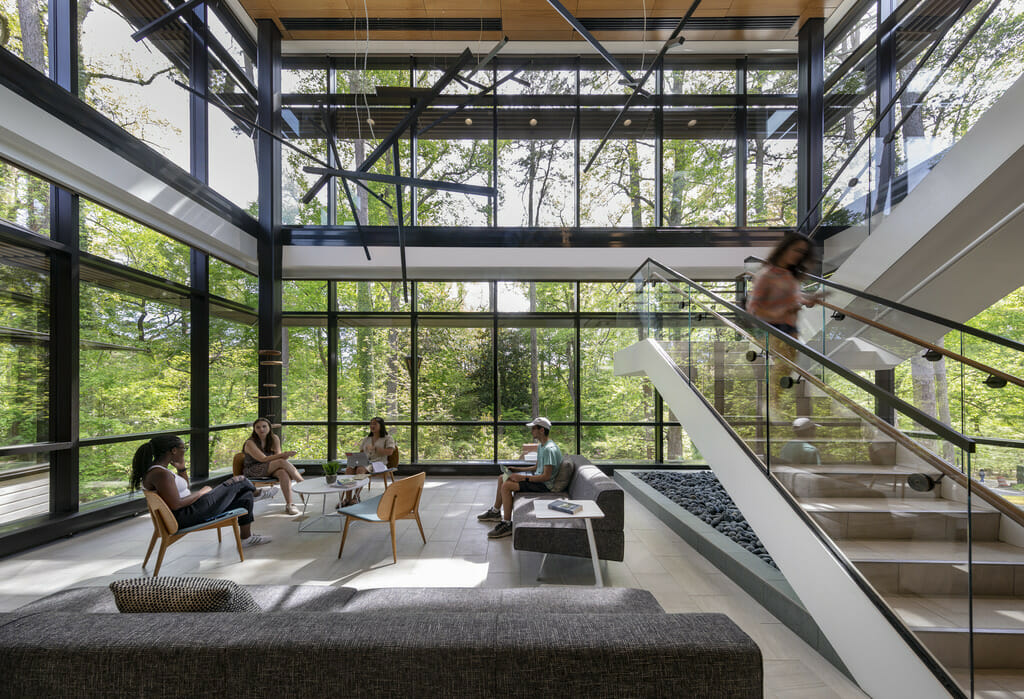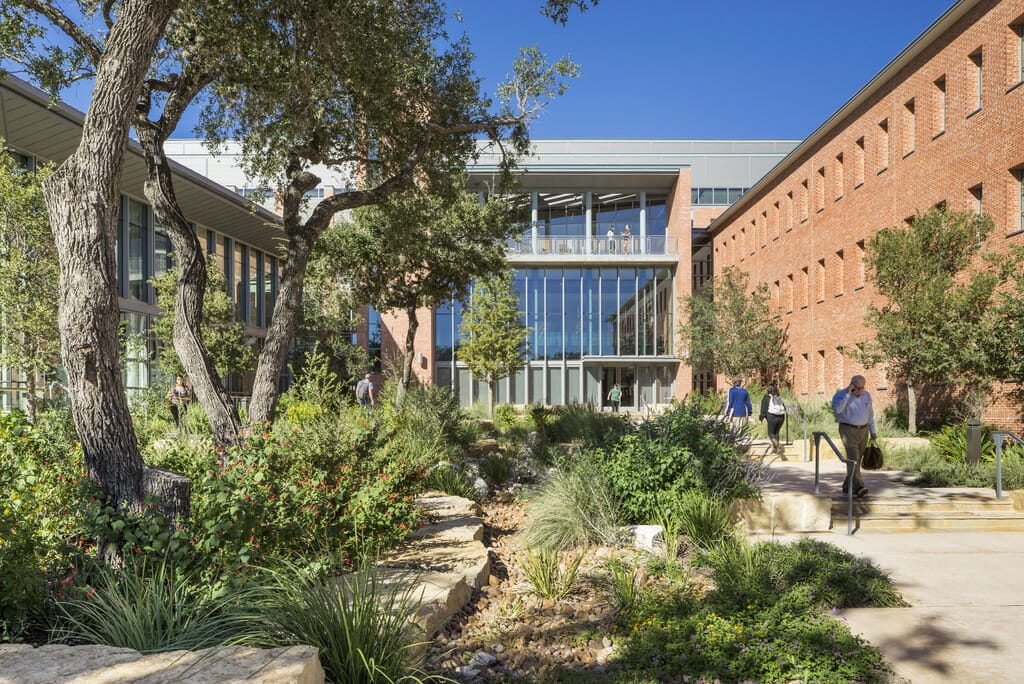ONLINE EXCLUSIVE
The Giving Tree Can Only Take So Much
Exploring the Relationship Between Humans and Trees in Combating Climate Change

College of William & Mary, McClead Tyler Wellness Center – this image really showcases how the importance of trees isn’t just from the perspective of the outside.
By Jessica Petro, PLA, ASLA, Lead Designer, Landscape Architect EYP
The Giving Tree by Shel Silverstein is a wonderful, classic tale that highlights the unbalanced relationship between a boy and a tree. This simple story’s strong message is especially pertinent even today, as it highlights the importance and need for us to rethink how we co-exist with nature and how our actions impact our ecosystems. Trees give us so much; they aid in pollution management, carbon sequestration, heat island reduction, water resource management, soil conservation, and more. But how can humans reciprocate? How can we give back to nature through high-performance landscape design, and how can thoughtful actions slow the effects of climate change?
We rely on trees and other plantings for a variety of reasons – one very important aspect to humans is that we rely on trees to breathe. “Through a process called photosynthesis, leaves pull in carbon dioxide and water and use the energy of the sun to convert this into chemical compounds such as sugars that feed the tree. But as a by-product of that chemical reaction oxygen is produced and released by the tree. It is proposed that one large tree can provide a day’s supply of oxygen for up to four people.”¹ Trees are actually one of our planet’s largest resources for sequestering carbon. According to The Nature Conservatory, trees store the collected carbon dioxide throughout their lives, helping to slow the building up of gases in our atmosphere that have been rapidly warming our planet.
Trees do so much more, however. These natural resources organically aid in pollution (in the air, water, and/or soil) management, trapping pollutants and even using some as nutrients. Similarly, through a sequestration process, they use carbon and convert it into their limbs, trunk, and roots. Trees are also vital for reducing heat island effect, as the leaves of a tree’s canopy aid in cooling the surrounding areas, since heat rays can reflect off them. Additionally, trees effectively and naturally manage water resources (effectively collecting and absorbing water through the roots), soil conservation, and biodiversity support. Finally, research clearly demonstrates that a connection to nature such as exposure to trees provides numerous health and wellness benefits, including bettering respiratory health, promoting social and emotional well-being, and reducing stress.
It’s hard to overstate the importance of tree preservation and tree planting in the fight to combat climate change. Humans can play a role by planting more trees to offset the carbon in the air and supporting practices that minimize the increased carbon and pollution in our environment. Both young and old trees are extremely vital to our environment and support the sequestering of carbon. While young trees are smaller and are limited in their photosynthesis due to their size, they need the carbon to grow. The preservation of large established trees are important not only for the stored carbon that already exists in the tree’s system, but due to their larger scale and surface area, they still continue to pull large amounts of carbon out of the air.
All of these factors are important as landscape architects approach initial site planning. By conducting an inventory and analyzing many components of a site, including its existing vegetation, designers can better understand the project site’s natural systems. Another successful strategy is thoughtfully placing buildings and site improvements to preserve existing vegetation where applicable and possible. ‘Applicable’ meaning if it is an invasive tree and/or in decline, removal is recommended, since a tree in decline (depending on its location/proximity to walkways and drives, etc.) can be a health, welfare, and/or safety hazard. ‘Possible’ meaning if the preservation doesn’t negatively affect the client’s defined program needs and ability to improve the site.
Recognizing the need for trees and advocating for their preservation, plantings, and reforestation (even as urban forests) is something we can all do, since everyone living on earth has some ownership/connection to the environment. From a design standpoint, it is crucial to understand how we can plan and plant for trees’ success. Taking a step back, what are a tree’s needs and what are best practices for planting and maintenance to ensure that they thrive and grow?

Trinity University, Center for Sciences and Innovation – Many oak trees were saved, highlighting the preservation of appropriate existing vegetation and in fact, designing the building/construction/infrastructure to make that a success.
Creating the right environment.
The best and most self-sustaining high-performance landscapes are correctly sited with a dedicated, appropriately-sized area for plantings. When planning a site, landscape architects examine not only the present day site and its need to be resilient and regenerative, but also consider the site’s needs and space requirements relative to the mature planting, ensuring that all plant material has the proper amount of area and best growing conditions in which to thrive. It’s also important to consider cold and heat hardiness, taking into account potential soil drainage and long-term sun exposure.
Designers should also avoid creating potential disturbances, like regrading around root zones, trunk, compaction, and other things that might negatively affect growth. Special care should be given to all existing plant material, but especially to established trees with large canopies. Understanding and careful management of disturbance is key since 90% of a tree’s roots are in the top 18” of the soil and often extend two to three times the dripline. In general it is best to minimize any disturbance by trees, but sometimes it is necessary due to construction requirements. To better understand the critical root zone for a tree as to minimize any disturbance, there are resources to explain how to appropriately size this protection zone, including measuring the diameter of a tree’s trunk at breast height (DBH) and using a multiplier. Another more general rule is to minimize any disturbance under and out to the edge of the tree’s canopy, also known as its dripline.²
Design that sets trees up for long-term success.
One aspect of a landscape architect’s role in a project is the design and documentation of planting plans. These plans thoughtfully select and define plant material specifications with the design intent of meeting the needs and aesthetic of the site. In designing a high-performance landscape, they also think about the utilization of native plant material and creating planting plans that are sustainable, resilient, and regenerative. To achieve this, a designer would need to consider the anatomy of trees and what they need to thrive. Additionally, since trees have varying needs (throughout the seasons and even years), landscape architects and owners must understand not only what types of trees are appropriate for any given space or region, but also, future requirements for maintenance and watering.
To that end, an excellent way to ensure success is to plant native (vs. incorporating exotic plants that require a lot of maintenance and don’t naturally grow in the area) and create spaces that are connective, as trees grow best in communities. The best case scenario for designing a native landscape involves a site that provides the opportunity to plant groupings and connected systems, rather than disconnected lines or fragmented landscapes. Advocating for larger greenspace area on project sites would ensure plantings that are diverse, support biodiversity, and have the ability to make a larger impact on reversing climate change. Further, a landscape with the capability to serve the environment is designed from the onset to seamlessly integrate with the local ecosystem. Good design incorporates the right size trees planted correctly within the right areas on site, offering the best environmental solution.
Tree care.
Education about, and respect for, trees is key. Unlike people or animals, trees cannot just get up and move to a better area when they are stressed or in a negative environment. They are rooted and susceptible, so we as humans need to be their advocates and a licensed arborist should be employed to assess and suggest treatment when trees show signs of stress. Arborists should be also involved when it comes to limb or full tree removal, IPM and other fertilizer and pesticide approaches, and other specialized needs, like soil aeration for the root zone of a tree, etc. Anyone taking part in the design or maintenance of high-performance landscapes should follow a landscape management plan that proactively manages and defines the care and maintenance needed for the continued growth of the landscape. For example, avoid spreading mulch too high – the natural flare of the trunk or root collar needs to be exposed and slightly above finish grade. More than four inches of mulch can limit oxygen from getting to the roots, something trees need to grow. Also, mowing a tree up to its trunk and/or weed whacking can ultimately cause damage to the trunk and expose it to diseases. Similarly, leaving the temporary guying and stalking longer than needed can adversely affect the tree’s growth. The guying and staking is initially incorporated to help anchor the tree while it establishes itself, but if left installed too long without adjustments to the wire it can actually girdle the trunk, since as the tree continues to grow, the diameter of the trunk increases. In addition, once the tree is rooted and there isn’t a concern of it falling over, removing the tree staking and guying is beneficial since it is said having a tree sway in the breeze stimulates growth and strengthens its trunk. Caretakers should also check for girdling roots (roots that encircle or wrap around the base of a tree’s trunk) and remove them early, because these roots can cause significant health and safety issues down the line.³
Through strategic and thoughtful design, preservation of existing vegetation and proper planting of new material, appropriate siting of trees, utilizing native species, and xeriscaping techniques, we can create a healthy landscape and set the trees up for success. On the other hand, by not actively thinking about and planning for new plantings and reforestation, we may create a negative impact on our natural resources. Many of today’s landscape architecture teams are rethinking how to develop and care for resilient and regenerative high-performance landscapes, while aiming to incorporate more green space into design and planning projects of all types. Moving forward into the future, we all must be mindful and respectful of the amazing resources in nature – becoming and remaining stewards of the trees as they do so much for us in return.
¹ https://www.usda.gov/media/blog/2015/03/17/power-one-tree-very-air-we-breathe
² http://www.ct.gov/deep/lib/deep/forestry/cttreeownersmanual.pdf
³ www.isa-arbor.com ; Pirone’s Tree Maintenance Seventh Edition by John R. Hartman, Thomas P. Pirone & Mary Ann Sall.
